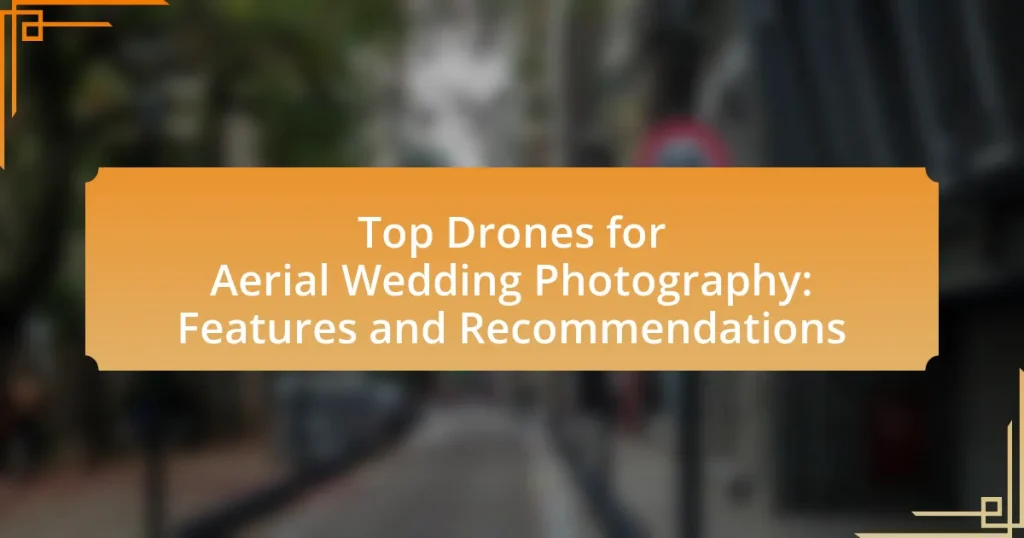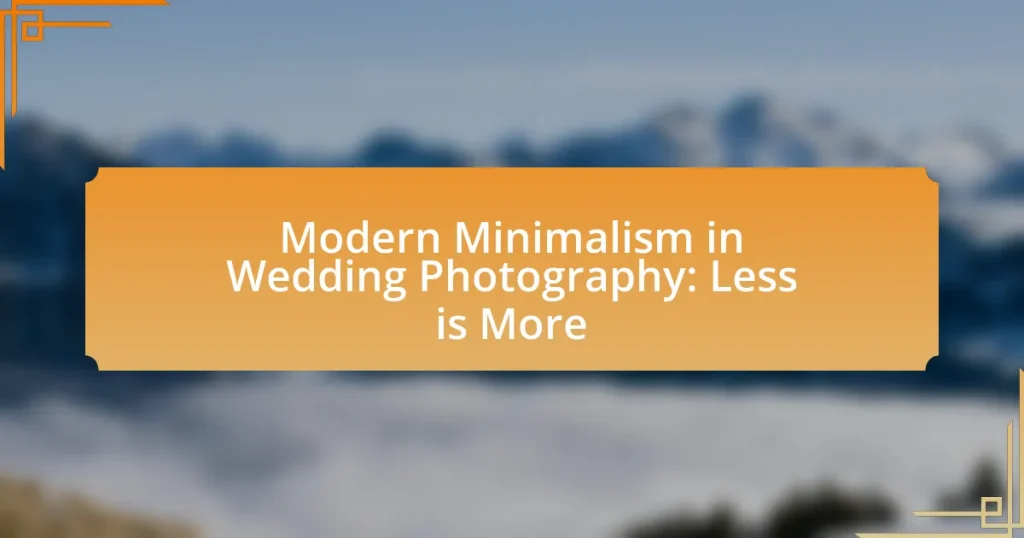The article focuses on the top drones for aerial wedding photography, highlighting models such as the DJI Mavic 3, DJI Air 2S, and Autel Robotics EVO Lite+. It outlines essential features to consider when selecting a drone, including camera quality, flight time, and stability, which directly impact the quality of wedding footage. Additionally, the article discusses the importance of safety features, compliance with local regulations, and best practices for effective drone operation during weddings. Techniques for enhancing aerial photography composition and troubleshooting tips for drone performance are also covered, providing a comprehensive guide for photographers looking to capture memorable wedding moments from the sky.
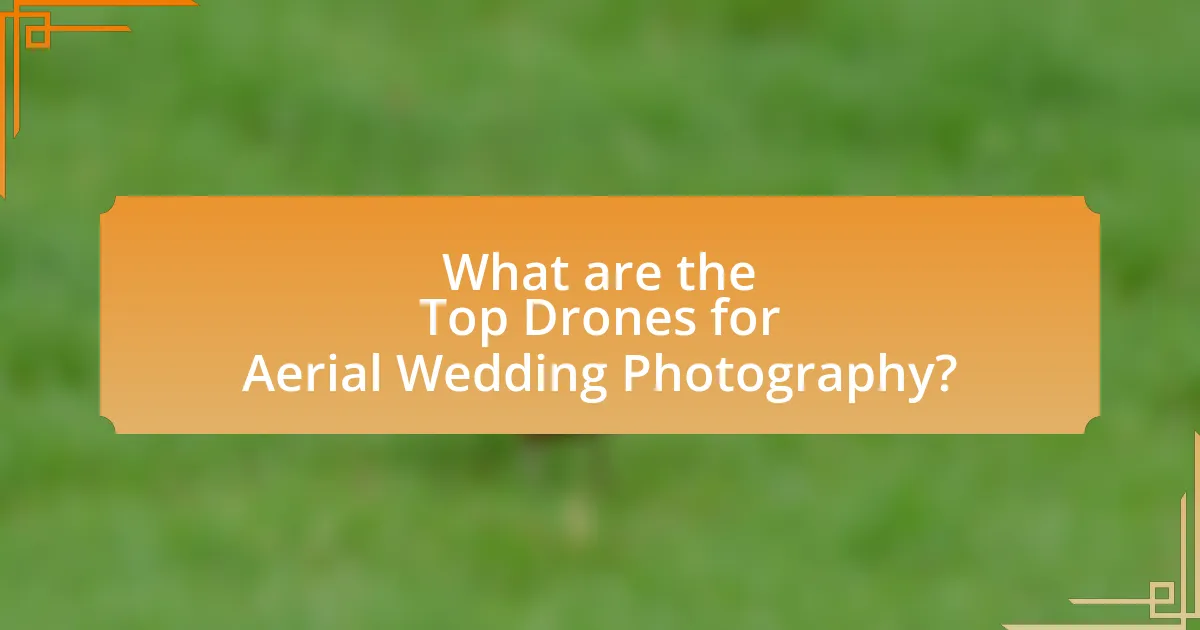
What are the Top Drones for Aerial Wedding Photography?
The top drones for aerial wedding photography include the DJI Mavic 3, DJI Air 2S, and Autel Robotics EVO Lite+. The DJI Mavic 3 features a dual-camera system with a 4/3 CMOS sensor, allowing for high-quality images and video, which is essential for capturing wedding moments. The DJI Air 2S offers a 1-inch sensor and advanced obstacle sensing, making it user-friendly for photographers of all skill levels. The Autel EVO Lite+ boasts a large 1-inch sensor and impressive low-light performance, ideal for evening weddings. These drones are recognized for their superior image quality, ease of use, and reliability, making them popular choices among wedding photographers.
How do you choose the right drone for wedding photography?
To choose the right drone for wedding photography, prioritize features such as camera quality, flight time, and ease of use. High-resolution cameras, ideally 4K or higher, ensure stunning images and videos, while a flight time of at least 20-30 minutes allows for capturing various moments without frequent recharging. Additionally, user-friendly controls and stability features, like GPS and obstacle avoidance, enhance the shooting experience and ensure safety during flights. These specifications are critical as they directly impact the quality of the wedding footage and the overall efficiency of the photography process.
What key features should you look for in a wedding photography drone?
When selecting a wedding photography drone, key features to consider include high-resolution camera capabilities, stability in flight, and extended battery life. High-resolution cameras, ideally 4K or higher, ensure that images capture the intricate details of the wedding day. Stability in flight, often achieved through advanced gimbal systems, is crucial for smooth video and sharp images, especially in dynamic environments. Extended battery life, typically around 25-30 minutes, allows for longer shooting sessions without frequent interruptions, ensuring that all moments are captured. These features collectively enhance the quality and reliability of aerial wedding photography.
How does camera quality impact aerial wedding photography?
Camera quality significantly impacts aerial wedding photography by determining the clarity, detail, and overall aesthetic of the images captured. High-quality cameras equipped with larger sensors and superior lenses produce sharper images with better color accuracy and dynamic range, essential for capturing the intricate details of wedding settings from above. For instance, drones with 4K cameras can capture images with four times the resolution of standard HD, allowing for stunning, high-definition photos that enhance the visual storytelling of the wedding day. Additionally, advanced camera features such as image stabilization and low-light performance further improve the quality of aerial shots, ensuring that even in challenging conditions, the photographs remain clear and vibrant.
What are the most popular drone models for wedding photography?
The most popular drone models for wedding photography include the DJI Mavic Air 2, DJI Phantom 4 Pro, and DJI Mini 2. The DJI Mavic Air 2 is favored for its compact size, 48MP camera, and 4K video capabilities, making it ideal for capturing high-quality aerial shots. The DJI Phantom 4 Pro is known for its superior image quality, 20MP camera, and advanced obstacle avoidance features, which are crucial for safe flying in complex environments. The DJI Mini 2 is appreciated for its lightweight design, ease of use, and 4K video recording, making it a great choice for beginners and professionals alike. These models are widely recognized in the wedding photography community for their reliability and performance.
What are the specifications of the DJI Mavic Air 2 for wedding photography?
The DJI Mavic Air 2 features a 1/2-inch CMOS sensor capable of capturing 48 MP still images and 4K video at 60 frames per second, making it suitable for high-quality wedding photography. It offers a maximum flight time of 34 minutes and a transmission range of up to 10 kilometers, allowing for extensive coverage of wedding venues. The drone includes advanced shooting modes such as SmartPhoto, which combines HDR, scene recognition, and other enhancements to optimize image quality. Additionally, it has a 3-axis gimbal for stable footage, ensuring smooth video capture during dynamic wedding events. These specifications collectively enhance the Mavic Air 2’s effectiveness in capturing memorable moments during weddings.
How does the Autel Robotics EVO Lite+ compare for aerial shots?
The Autel Robotics EVO Lite+ excels in aerial shots due to its impressive 50MP camera and 1-inch CMOS sensor, which provide high-resolution images and superior low-light performance. This drone supports 6K video recording at 30 frames per second, allowing for smooth and detailed footage, essential for capturing the nuances of wedding events. Additionally, the EVO Lite+ features advanced stabilization technology, ensuring steady shots even in windy conditions, which is crucial for outdoor weddings. Its ability to shoot in HDR enhances dynamic range, making it suitable for various lighting scenarios often encountered during weddings.
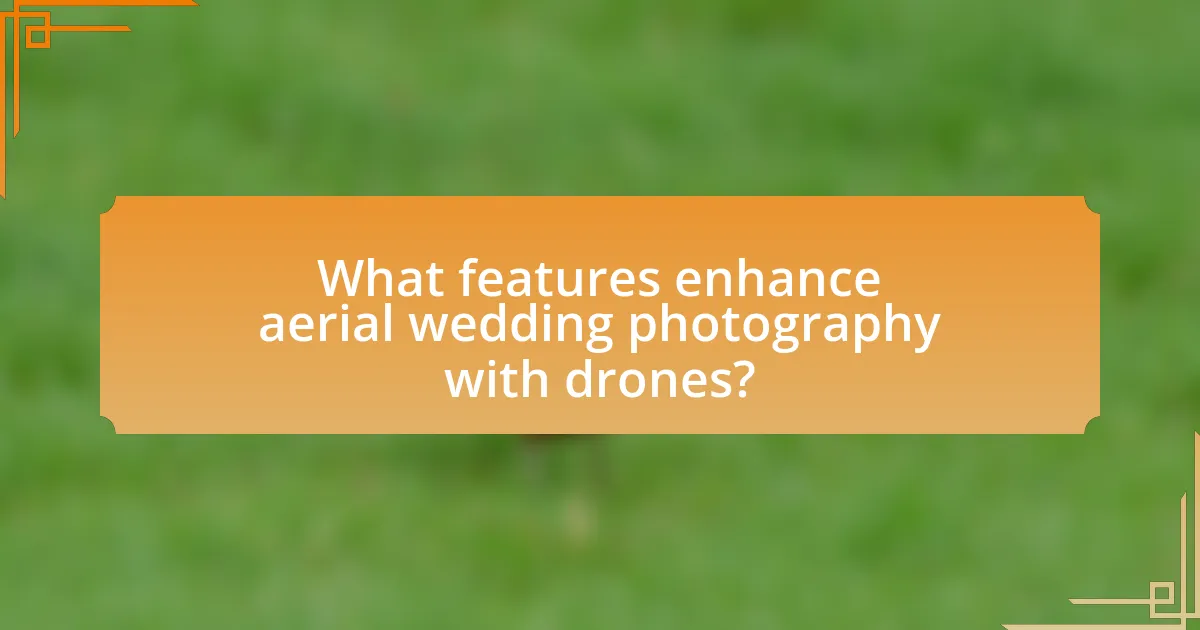
What features enhance aerial wedding photography with drones?
High-resolution cameras enhance aerial wedding photography with drones by capturing detailed images and videos. Drones equipped with 4K or higher resolution cameras provide clarity and vibrancy, essential for preserving the beauty of wedding moments. Additionally, features like gimbal stabilization ensure smooth footage, reducing motion blur and enhancing the overall quality of the shots. Advanced flight modes, such as follow-me and waypoint navigation, allow for dynamic and creative angles, making it easier to capture unique perspectives of the event. Furthermore, long battery life enables extended shooting sessions, ensuring that all key moments are documented without interruption.
How does flight time affect your wedding photography experience?
Flight time significantly impacts your wedding photography experience by determining how long you can capture aerial shots during the event. Longer flight times allow for more extensive coverage of the venue and the ability to capture various moments throughout the day, enhancing the overall storytelling of the wedding. For instance, drones with flight times exceeding 25 minutes can provide ample opportunity to photograph different angles and scenes without the need for frequent battery changes, which can disrupt the flow of the event. This capability is crucial for capturing dynamic moments, such as the ceremony, reception, and candid interactions, ensuring that no significant memories are missed.
What is the average flight time of popular wedding drones?
The average flight time of popular wedding drones is typically between 20 to 30 minutes. This duration is common among well-known models such as the DJI Mavic Air 2 and the DJI Phantom 4, which are frequently used for aerial wedding photography. These drones are designed to balance performance and battery life, allowing for sufficient time to capture essential moments during a wedding ceremony or reception.
How can you extend the flight time during a wedding shoot?
To extend the flight time during a wedding shoot, utilize high-capacity batteries and optimize drone settings for efficiency. High-capacity batteries, such as those with a capacity of 5000mAh or more, can significantly increase flight duration, often providing up to 30 minutes of flight time. Additionally, adjusting settings like reducing the drone’s speed, minimizing aggressive maneuvers, and using GPS mode can enhance battery life. Studies show that flying at a steady pace and avoiding rapid ascents or descents can conserve energy, thereby extending flight time.
What safety features are essential for drones used in weddings?
Essential safety features for drones used in weddings include obstacle avoidance systems, GPS stabilization, and fail-safe return-to-home functions. Obstacle avoidance systems help prevent collisions with people, structures, or other objects, ensuring the safety of guests and the integrity of the venue. GPS stabilization provides accurate positioning, which is crucial for maintaining stable flight paths and capturing high-quality images without erratic movements. Fail-safe return-to-home functions automatically guide the drone back to its launch point in case of low battery or signal loss, minimizing the risk of loss or damage. These features collectively enhance the safety of drone operations during weddings, protecting both the equipment and attendees.
How do obstacle avoidance systems work in wedding drones?
Obstacle avoidance systems in wedding drones utilize a combination of sensors and algorithms to detect and navigate around obstacles in real-time. These systems typically employ ultrasonic, infrared, or visual sensors to identify nearby objects, allowing the drone to calculate its position relative to them. For instance, when a drone approaches an obstacle, the onboard software processes the sensor data to determine the best course of action, such as altering its flight path or altitude to avoid a collision. This technology enhances safety and ensures smooth operation during aerial photography, which is crucial for capturing important moments without interruptions.
Why is GPS functionality important for aerial photography?
GPS functionality is important for aerial photography because it enables precise location tracking and geotagging of images. This accuracy allows photographers to document the exact coordinates of each shot, which is essential for organizing and retrieving images later. Additionally, GPS data enhances post-processing capabilities, enabling the integration of location information into mapping software or for creating detailed photo albums. Studies show that drones equipped with GPS can achieve positioning accuracy within a few centimeters, significantly improving the quality and usability of aerial photographs.
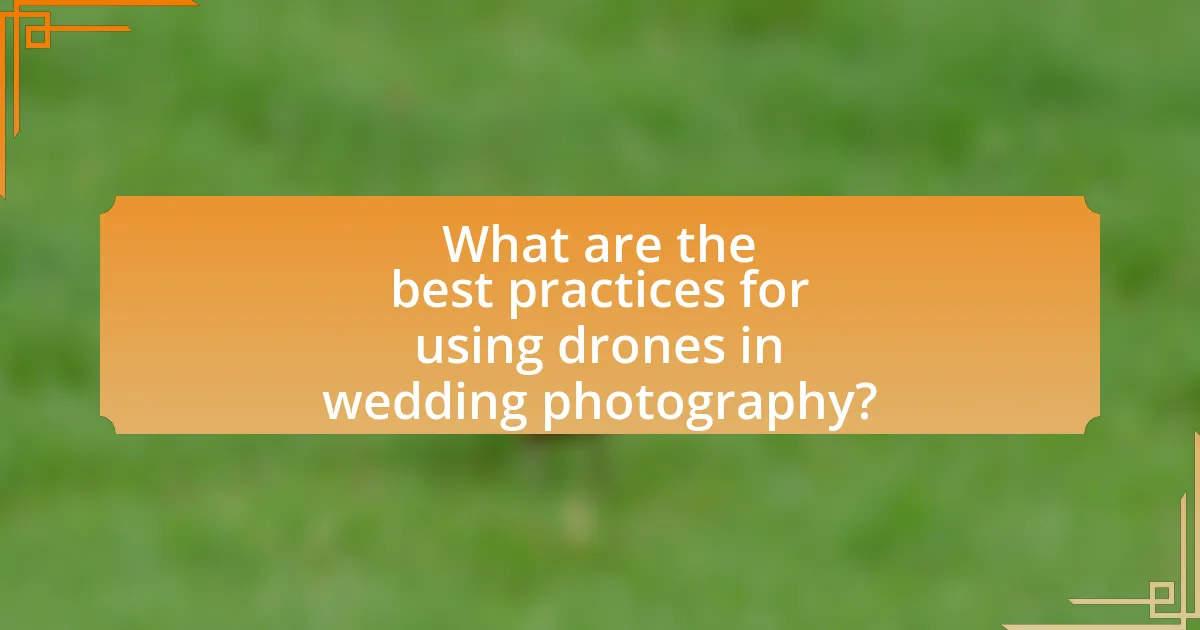
What are the best practices for using drones in wedding photography?
The best practices for using drones in wedding photography include obtaining necessary permits, ensuring safety, and planning flight paths in advance. Obtaining permits is crucial as many locations require legal authorization for drone use, which helps avoid fines and legal issues. Safety is paramount; operators should maintain a safe distance from guests and structures to prevent accidents. Additionally, planning flight paths allows photographers to capture key moments without disrupting the ceremony, ensuring that the drone complements the event rather than distracts from it. These practices enhance the overall quality and professionalism of aerial wedding photography.
How can you ensure compliance with local drone regulations during weddings?
To ensure compliance with local drone regulations during weddings, obtain the necessary permits and familiarize yourself with specific laws governing drone use in the area. Local regulations often require operators to register their drones, adhere to altitude limits, and avoid restricted airspace, such as near airports or crowded venues. For instance, the Federal Aviation Administration (FAA) in the United States mandates that drone operators follow guidelines that include flying below 400 feet and maintaining visual line-of-sight. Additionally, checking with local authorities or the venue for any specific restrictions can further ensure adherence to regulations.
What are the common legal restrictions for flying drones at wedding venues?
Common legal restrictions for flying drones at wedding venues include compliance with Federal Aviation Administration (FAA) regulations, which mandate that drones must be flown below 400 feet, within the operator’s line of sight, and not over people unless specific waivers are obtained. Additionally, many wedding venues may have their own policies prohibiting drone use due to privacy concerns or safety issues. Local laws may also impose restrictions, such as no-fly zones near airports or crowded areas. These regulations are designed to ensure safety and privacy, making it essential for drone operators to verify both federal and local guidelines before flying at wedding venues.
How can you obtain necessary permits for drone usage at events?
To obtain necessary permits for drone usage at events, you must first check local regulations and contact the appropriate aviation authority, such as the Federal Aviation Administration (FAA) in the United States. The FAA requires drone operators to apply for a Part 107 waiver if the event is in controlled airspace or if the drone will be used for commercial purposes. Additionally, you may need to secure permission from the event venue and obtain liability insurance. Local laws may also require permits from city or county officials, especially for large gatherings. Compliance with these regulations ensures safe and legal drone operation at events.
What tips can improve your aerial wedding photography skills?
To improve aerial wedding photography skills, focus on mastering drone controls and understanding composition techniques. Proficient drone operation allows for smooth movements and precise framing, which are essential for capturing dynamic wedding moments from above. Additionally, applying the rule of thirds and leading lines can enhance visual interest in aerial shots. Research indicates that well-composed images significantly increase viewer engagement, making these techniques vital for effective storytelling in wedding photography.
How can you plan your shots effectively before the wedding day?
To plan your shots effectively before the wedding day, create a detailed shot list that outlines specific moments and angles you want to capture. This list should include key events such as the ceremony, reception, and couple portraits, ensuring you cover all essential aspects of the day. Additionally, conduct a site visit to familiarize yourself with the venue’s layout and lighting conditions, which will help you determine the best drone flight paths and angles for aerial shots. Researching the couple’s preferences and any must-have shots will further refine your planning. By preparing in advance, you can ensure a smooth shooting process and capture the wedding day beautifully.
What techniques can enhance the composition of aerial wedding photos?
Techniques that can enhance the composition of aerial wedding photos include utilizing leading lines, framing, and the rule of thirds. Leading lines, such as pathways or natural elements, guide the viewer’s eye toward the couple, creating a sense of depth. Framing involves using elements like trees or arches to encase the subjects, adding context and focus. The rule of thirds suggests positioning key elements along grid lines or intersections, which can create a more balanced and engaging image. These techniques are supported by principles of visual composition that emphasize the importance of structure and balance in photography, leading to more visually appealing results.
What troubleshooting tips should you know for drone photography?
To troubleshoot drone photography effectively, ensure that the drone’s firmware is updated, as outdated software can lead to performance issues. Additionally, check the battery levels before flight; low battery can cause erratic behavior or loss of control. Inspect the camera settings to confirm they are optimized for the lighting conditions, as incorrect settings can result in poor image quality. Furthermore, verify that the GPS signal is strong, as weak signals can affect stability and positioning. Lastly, familiarize yourself with the drone’s return-to-home feature, which can be crucial in case of signal loss or low battery situations. These steps are essential for maintaining optimal performance and capturing high-quality aerial images.
